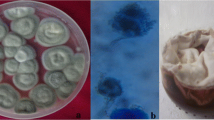Abstract
The second instar larvae of the malaria vector mosquito,Anopheles arabiensis,were more susceptible to Bacillus thuringiensis var. israelensis (IPS-82) and B. sphaericus (SPH-88) than the third instar larvae. The LC 50 values were 1.0 ΜgI-1 and 1.8 ΜgI-1 for IPS-82 against second and third instar larvae respectively, after 48 h of exposure. The LC50 values for SPH-88 were 3.6 Μg {siI-1} against the second instar larvae and 7.6 ΜgI-1 against the third instar larvae of An. arabiensis. The larvicidal efficacy of SPH-88 was significantly less than IPS-82. The potential of IPS-82 for the control of An. arabiensis in malaria endemic areas is promising.
Similar content being viewed by others
References
Abdel-Hameed, A., Carlberg, G. & Tayeb, O.M. 1990 Studies onBacillus thuringiensis H-14 strains isolated in Egypt.l. Screening for active strains.World Journal of Microbiology and Biotechnology 6, 229–304.
Bruce-Chwatt, L.J. 1985Essential Malariology, Second edition. London: Oxford University Press.
Darwazeh, H.A., Zgomba, M. & Mulla, M.S. 1990 Environmental factors affecting the efficacy of microbial control agents. In:Mosquito Control Research, ed Coats, J. p. 23. California: University of California Press.
Finney, DJ. 1971Probit analysis, Third edition. Cambridge: Cambridge University Press.
Foo, A.E.S. & Yap, H.H. 1982 Comparative bioassays ofBacillus thuringiensis H-14 formulations against four species of mosquitoes in Malaysia.Southeast Asian Journal of Tropical Medicine and Public Health 13, 206–210.
Geberemariam, N. 1988 Malaria. In:The Ecology of Health and Disease in Ethiopia, eds Zein, Z.A. & Kloos, H. pp. 136–150. Addis Ababa: EMPDA.
Gill, S.S., Cowles, E.A. & Pietrantonio, P.V. 1992 The mode of action ofBacillus thuringiensis endotoxins.Annual Review of Entomology 37, 615–636.
Goldeberg, L.J. & Margalit, J. 1977 A bacterial spore demonstrating rapid larvicidal activity againstAnopheles sergenti, Uranotaenia urguicutata, Culex univitattus, Aedes aegypti andCulex pipens.journal of the American Mosquito Control Association 37, 355–358.
Kalfon, A., Charles, J.F., Bourouni, C. & De Berjack, H. 1984 Sporulation ofBacillus sphaericus 2297: An electron microscopic study of crystal-like inclusion biogenesis and toxicity to mosquito larvae.Journal of General Microbiology 130, 893–900.
Kellen, W.R., Clark, T.B., Lindegren, J.E., Ho, B.C., Rogoff, M.H. & Singer, S. 1965Bacillus sphaericus Neide as a pathogen of mosquitoes.Journal of Invertebrate Pathology 7, 442–448.
Mekuria, Y., Gezahegn, T., Gabriel, G.W., Tilahun, D. & Petrarca, V. 1991 Cytogenetic characterization of two laboratory colonies ofAnopheles arabiensis Patton from Ethiopia.Parassitologia 33, 225–227.
Mulla, M.S. & Channey, J.D. 1994 Evaluation ofBacillus sphaericus liquid concentrate formulation againstCulex mosquitoes. In:Mosquito Control Research, ed March, J. pp. 19–21. California: University of California Press.
Nugud, A. & White, G. 1982 Evaluation ofBacillus thuringiensis serotype H-14 formulations as larvicides forAnopheles arabiensis (species B of theAnopheles gambiae complex).Journal of the American Mosquito Control Association 42, 36–40.
Porter, A.G., Davidson, E.W. & Weilliu, U.J. 1993 Mosquitocidal toxins of bacilli and their genetic manipulation for effective biological control of mosquitoes.Microbiological Reviews 57, 838–861.
Ramoska, W.A., Singer, S. & Levy, R. 1977 Bioassay of three strains ofBacillus sphaericus on field collected mosquito larvae.Journal of Invertebrate Pathology 30, 151–154.
Seyoum, A. 1995 Mosquito larvicidalBacillus strains from Ethiopia. MSc. thesis, Addis Ababa University.
Swaroop, S. 1966Statistical Methods in Malaria Eradication, World Health Organization monograph series No.51.
Van Rie, J., Jancens, S., Hofte, H., Degheele, D. & Van Mellaen, H. 1990 Receptors on the brush border membrane of the insect mid-gut as determinants of the specificity ofBacillus thuringiensis delta endotoxins.Applied and Environmental Microbiology 56, 1378–1385.
Weiser, J. 1991Biological Control of Vectors. London: John Wiley and Sons.
Wraight, S.P., Molloy, D., Jamnback, H. & Mccoy, P. 1981 Effects of temperature and instar on efficacy ofBacillus thuringiensis var.israelensis andBacillus sphaericus strain 1593 againstAedes Stimulans larvae.Journal of Invertebrate Pathology 38, 78–87.
Zahar, A.R. 1985 Vector bionomics in the epidemiology and control of malaria. Part I, Section III. World Health Organization mimeographed document.VBC/MAP/85.3.
Author information
Authors and Affiliations
Rights and permissions
About this article
Cite this article
Seyoum, A., Abate, D. Larvicidal efficacy ofBacillus thuringiensis var. israelensis andBacillus sphaericus onAnopheles arabiensis in Ethiopia. World J Microbiol Biotechnol 13, 21–24 (1997). https://doi.org/10.1007/BF02770802
Received:
Accepted:
Issue Date:
DOI: https://doi.org/10.1007/BF02770802




